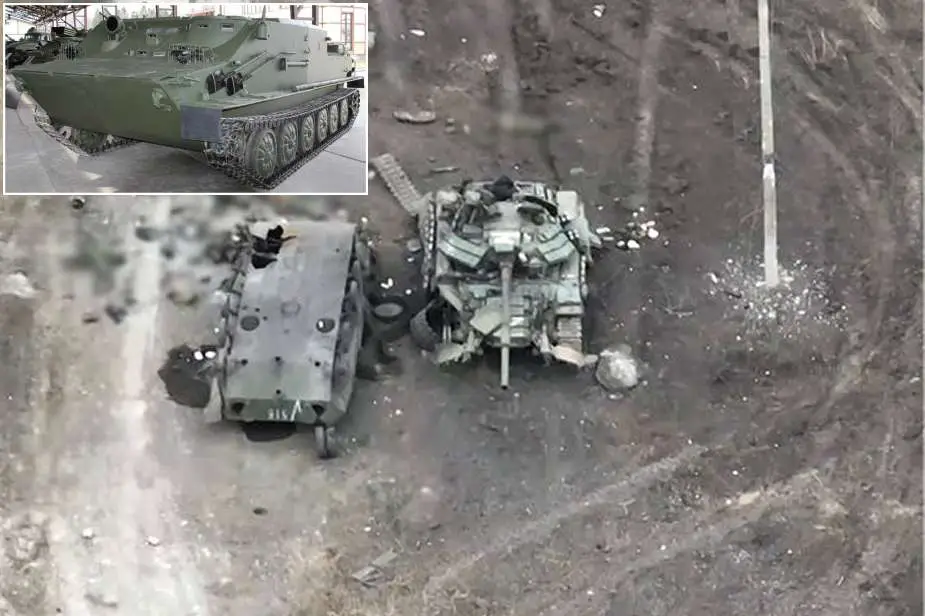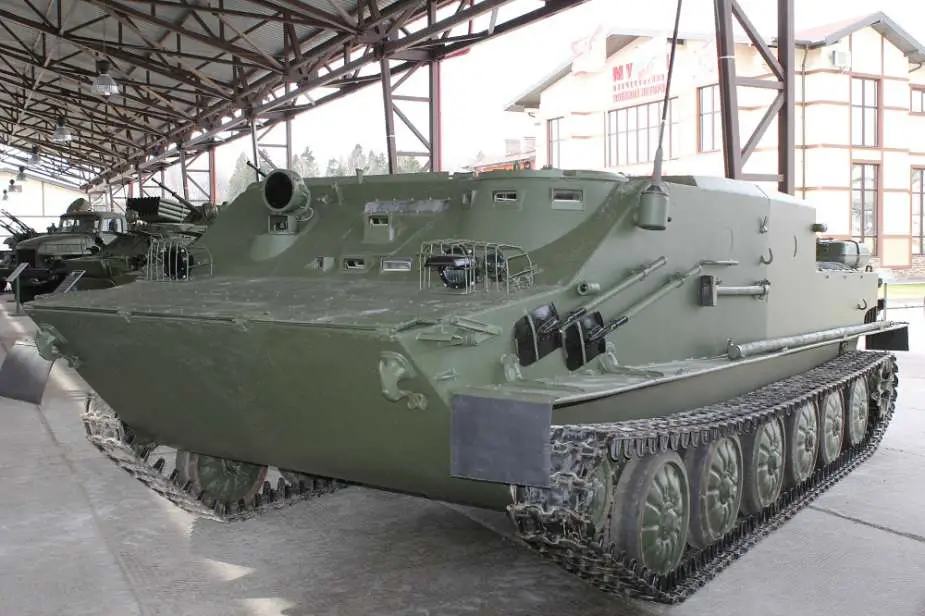- Army
- Conflicts in the world
- Israel - Iran conflict 2025
- Pakistan - India Conflict 2025
- Russia Ukraine War 2022
- Libya conflict day by day
- HAMAS - Israel War 2023
- Operation Serval in Mali French Army
- Sangaris operation Central African Republic
- Sangaris opération militaire République Centreafrique
- Ukraine - Russia conflict
- Syria conflict news
- Defence & Security Industry Technology
- Armies in the world
- Analysis Defense and Security Industry
- Conflicts in the world
- Navy
- Air
Ukraine destroys Russian Stalin-era museum piece BTR-50P APC
As reported by Btvt on October 15, 2023, the 110th mechanized brigade of the Ukrainian Armed Forces destroyed a Russian BTR-50P armored personnel carrier, along with a T-64BV tank equipped with a KMT-6 mine trawl, in the ongoing conflict for Avdiivka, a city located in Ukraine's Donbas region. This marks the first documented loss of a BTR-50P, the first Soviet armored personnel carrier with origins dating back to the Stalin era.
Follow Army Recognition on Google News at this link

Ukrainian Forces destroyed a Russian BTR-50P armored personnel carrier, along with a T-64BV tank, near Avdiivka, a city located in Ukraine's Donbas region (Picture source: Telegram and Wikimedia)
The BTR-50P project officially commenced on August 15, 1949, during the era of Joseph Stalin, when three major Soviet companies, the VNII-100, the Krasnoe Sormovo Plant, and the Chelyabinsk Kirov Plant (ChKZ), were entrusted with its development. The project was led by Nikolai Fedorovich Shashmurin, a renowned tank designer whose previous work included various Soviet tank models such as the KV-1, KV-85, IS-1, IS-2, IS-2Sh, and IS-7. Within an astonishingly short period, the blueprints for the BTR-50P were finalized by November 1, 1949.
The BTR-50P was designed to meet various criteria, including troop and cargo transport, amphibious capabilities, and firepower. Testing showed its ability to fire while in motion and its adaptability to various artillery, such as the ZIS-2 57mm and the D-44 85mm anti-tank guns. After multiple rounds of testing, the BTR-50P was officially adopted into the Soviet army in April 1954 under Nikita Khrushchev's leadership.
This pioneering tracked armored personnel carrier featured bulletproof armor with thicknesses ranging from 6 to 13mm. The BTR-50P had the capacity to carry up to 12 soldiers, transport up to 20 soldiers across water obstacles, and haul cargo weighing up to 2 tons. It was produced in two versions, with and without an armored roof. Its two-person crew, consisting of a driver and commander, operated the control compartment at the front of the vehicle.
Powered by a V-6PVG diesel engine generating 240 horsepower, the BTR-50P could accelerate to speeds of 45 km/h on the highway and 10 km/h on the water. The vehicle had a cruising range of 250 km on the highway. The engine was positioned in the stern, aligned with the longitudinal axis of the hull, and the chassis and transmission components, including the engine, were adapted from the PT-76 light amphibious tank.
The BTR-50P's armament underwent several changes. Testing initially equipped it with a 12.7mm DShK machine gun. Production versions came in two variations: those without weapons and those fitted with a 7.62mm SGMB machine gun, converted from the SG-43 Goryunov heavy machine gun developed in 1943.
In 1959, the BTR-50P underwent an upgrade, becoming the BTR-50PK with the addition of a roof over the troop compartment. This modification was prompted by combat experiences during the Hungarian Revolution in 1956, which exposed the vulnerability of soldiers in the open troop compartment to attacks involving grenades or Molotov cocktails.
Several other versions and modifications followed over the years, including the BTR-50PU and BTR-50PN command and staff vehicles. Many BTR-50Ps from the 1970s were repurposed as technical assistance vehicles (MTVs). In total, approximately 6,500 vehicles of various modifications were manufactured during its production years from 1954 to 1970.

A BTR-50 APC at the Museum of Russian Military History in the village of Padikovo, Russia (Picture source: Wikimedia)
The BTR-50P, a vehicle with distinct features for its era, had tactical and technical qualities that were noteworthy. Several factors may explain Russia's reconsideration of the use of the now completely outdated BTR-50P armored personnel carriers.
Russian military factories are currently under significant pressure to produce modern military equipment, particularly tanks and self-propelled howitzers. This heightened demand for these systems can affect the production capacity available for armored personnel carriers. In such circumstances, revisiting the BTR-50P, an existing platform, could be viewed as a practical response to address the need for additional armored transport vehicles.
The BTR-50P has been in service for over seven decades. Despite its age, it offers certain advantages. It can accommodate up to 20 paratroopers or carry substantial ammunition loads, surpassing the capacity of some other tracked vehicles like the MT-LB, which accommodates only 11 individuals, or the MT-LBu (8 soldiers). This exceeds the capacity of even more modern wheeled armored personnel carriers such as the BTR-80 or the BTR-90, both capable of accommodating 10 people.
The BTR-50P has demonstrated its off-road and amphibious capabilities, making it suitable for various operational scenarios, a particularly vital feature for military vehicles operating in Ukraine.
The vehicle is also known for its straightforward and dependable design, which facilitates field repairs and reduces operational downtime. In Ukraine, where efficient maintenance and quick turnaround are paramount, having equipment that can be serviced on-site by unqualified conscripts is advantageous for the Russian Armed Forces.
Lightly armored personnel carriers are highly valued for their capacity to shield personnel and ammunition from random fragments, bullets, and enemy attacks. In situations necessitating such protection, such as second-line troop transport, the BTR-50P's simplicity can be advantageous. However, it should be noted that in frontline combat situations, these vehicles are as protective as a cardboard box.
Critics may highlight limitations, such as relatively weak protection and a fuel-hungry engine. Nevertheless, these concerns can potentially be addressed through upgrades aimed at enhancing fuel efficiency and protection. Given its age, modernization is plausible to align the BTR-50P with the capabilities of the MT-LB, thus creating a new hybrid platform capable of carrying the entire Russian arsenal, except (for the time being) S-300 missiles.
Finally, the primary reason behind the resurgence of these vehicles on the battlefield is likely multifaceted. Given the substantial losses of modern equipment, the adaptation of armored personnel carriers to carry weapons, and the likely overburdened production lines of Russian factories, be it for manufacturing or equipment repair, it is probable that the Russian Armed Forces do not currently possess immediate alternatives.
This aspect might explain the Russian Forces' revisitation of their entire arsenal, which includes Soviet-era vehicles such as T-54/55 and T-62 tanks, rare armored recovery vehicles, unique BTR-90 Rostok IFV, or ZSU-23-4 anti-aircraft guns. While certain equipment may have been retired during peacetime, the exigencies of wartime can lead to the reutilization of previously retired equipment, especially when no immediate alternatives are at hand to meet the military's requirements.


























